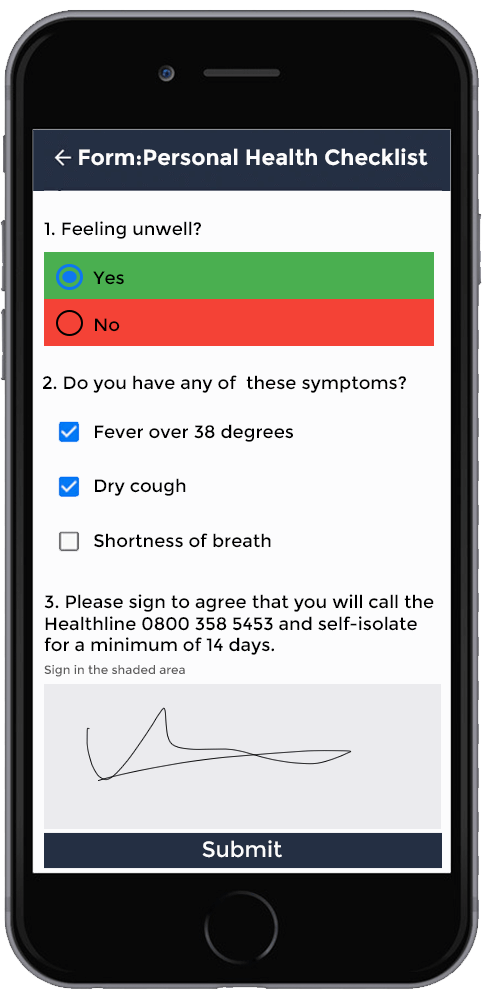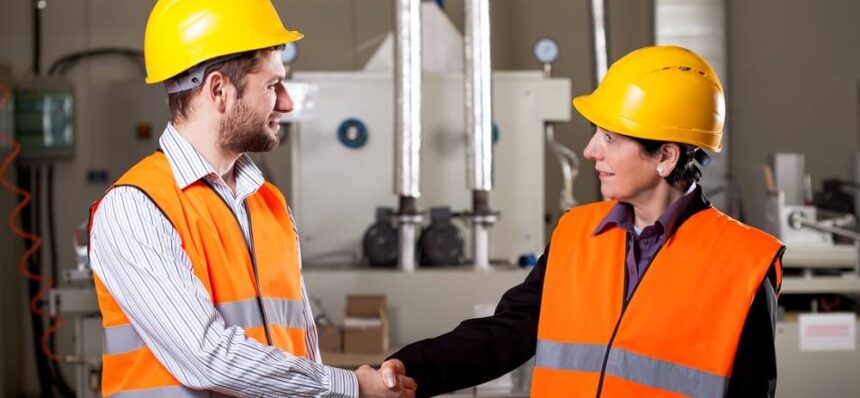As we continue to navigate the COVID-19 pandemic, new resources, regulations, and recommendations for construction contractors continue to change and stack upon one another. For contractors, the pressure to maintain a safe working environment is higher than ever.
In this article, you’ll find critical resources from around the web that will enable your construction crews to stay safe, stay compliant, and keep building.
COVID-19 basics
To start, contractors must understand what COVID-19 is, its symptoms, and how it spreads.
The virus is known to spread from person to person through close contact: when an infected person coughs or sneezes, the respiratory droplets carry the virus to nearby people and surfaces.
Basic protection
As with many viruses and bacteria, frequent and thorough washing of your hands and/or use of a hand sanitizer with a high concentration of alcohol (60% or more) is an essential form of protection. Mouth covers/masks are highly recommended as well, and they must completely cover the person’s nose and mouth.
Contractors need a plan
The impacts of COVID-19 on a job site can be tremendous with substantial absenteeism, delayed/postponed projects, so, contractors need to have a plan in place. Plans allow contractors to prepare, prevent, and respond to exposure. The CDC Pandemic Flu Checklist for Administrators encourages employers to follow up after a pandemic as well to improve safety measures in the workplace.
An effective plan will include but is not limited to pre-screening, best practices, social distancing, employee education, and enablement.
Pre-screening for COVID-19 on job sites
Make sure staff, crews, and visitors are checking for symptoms regularly. It’s important to discourage them from working if they are sick. While many people may not want to miss work for financial reasons, the recent Families First Coronavirus Response Act will act as a safety net while limiting the risk of spreading the illness across a job site.
Here is a questionnaire from Associated General Contractors of America (AGC). Their recommendation is to have anyone visiting a job site fill this out prior to entering to help limit risks.
Best practices & social distancing
Everyone within your business needs to participate in safety and prevention methods, from administrative staff, to the boots on the ground.
Basic infection prevention
- Washing hands thoroughly and frequently
- Using mouth covers
- Provide information, instruction and training on the safe use, decontamination, maintenance and disposal of any PPE provided, including washing hands before and after using PPE
- Encourage employees to cover mouth and nose when coughing and sneezing
- Encourage employees to stay home if they are sick
- Educate employees on how to disinfect at home
- Isolate employees that may be at risk to prevent further infection
- Understand how to stay safe when social distancing is not possible
Social distancing
There are many ways contractors can implement social distancing (staying 6 feet apart from one another):
- Splitting up crews to smaller groups
- Reducing or eliminating in-person meetings as much as possible
- Minimize contact during exchanges/pickups/deliveries
- Limit room capacities
Shared tools, plant, equipment and work areas
Sharing tools and equipment should be avoided whenever possible. If they must be shared, employers must:
- Provide cleaning products and make them available as tools, plant and equipment move around site
- Ensure all operators wash their hands thoroughly before and after use
- Ensure all parts of tools, plant and equipment are wiped down before use
- Regularly disinfect phones, desks, offices and computers. Shared use between these items should be avoided.
Enabling best practices
Contractors should make it as easy as possible for employees to follow guidelines and best practices. This will be beneficial to all stakeholders as it will help to minimize the risk.
For example, crews in the field may not have access to running water to wash their hands. To help them comply with the safety plan, provide hand sanitizer to crews or install a DIY hand-washing station on site.
The National Utility Contractors of America (NUCA) has also outlined a resource for contractors to use during this time. The pamphlet outlines more suggestions on minimizing exposure, including:
- Banning ride-sharing/carpooling
- Running training and orientations on COVID-19 on a weekly basis
- Establishing a touchless temperature scan protocol
- Keeping a daily log of all workers and visitors to a site
Find more recommendations from OSHA here.
COVID-19 is a recordable illness
It is the contractor’s responsibility to minimize the risk to staff and crews on the job. If a contractor is reported for poor practices, OSHA will plan and investigate if necessary.
COVID-19 is a recordable illness, but it can be difficult to determine if an employee contracted the illness throughout the course of their work. As a result, OSHA is enforcing record-keeping when:
“There is objective evidence that a COVID-19 case may be work-related. This could include, for example, a number of cases developing among workers who work closely together without an alternative explanation; and
The evidence was reasonably available to the employer. For purposes of this memorandum, examples of reasonably available evidence include information given to the employer by employees, as well as information that an employer learns regarding its employees’ health and safety in the ordinary course of managing its business and employees.”
Upon receiving complaints against a contractor, OSHA will assess the possibility of off-site investigations on a case-by-case basis. OSHA has also recognized that meeting compliance requirements may prove to be challenging for some at this time with limited resources. During an inspection, OSHA will assess an employer’s attempts at meeting these requirements, which will play a role in the final citation.
If COVID-19 breaks out on a job site, contractors could be looking at considerable financial and reputational damage to the business. With enforcement in a gray area, the risk is higher than ever for the industry.
Families First Coronavirus Response Act
Finally, contractors should be aware of the Families First Coronavirus Response Act (FFCRA), which is in effect through the rest of 2020. The Act prioritizes the well-being of families impacted by the pandemic and places additional responsibilities on employers.
Under the act, employers must provide at least two weeks of fully paid leave to employees that are impacted by COVID-19. Employees may qualify for paid leave for a number of reasons, including falling ill themselves or caring for a family member that has been infected.
In addition, employers must notify employees of their rights under the Act. This poster by the Department of Labor covers the bases for notifying employees as well as the details of paid leave under the Act.
With more regulations and policies in place, it may be time to look for a solution that will help keep you organized. Require crews to fill out searchable safety forms and requests on a daily basis with Assignar Forms.
Stay safe. Stay compliant. And keep building.
View OSHA’s full guidance and recommendations resource here.
The digital solution
Assignar is the operations platform built for sub and self-perform contractors. As a cloud-based platform, your office workers can work remotely to enable physical distancing. Your staff can remotely access all training, certifications, schedules, safety forms, and timesheets without.
The mobile app enables contractors to abide by the recommendations laid out by OSHA. Workers can submit their timesheets and safety forms through their smartphones. Each submission includes the time-stamp and geo-location.
Communicating job details, new procedures, and expectations are paramount in running your business smoothly throughout this time. Receive and share all of the important information in real time with Assignar.
Learn how other sub and self-perform contractors are using Assignar to tackle COVID-19.
Resources:
Guidance for the construction workforce | OSHA
Guidance on Preparing Workplaces for COVID-19 | OSHA
COVID-19 as a recordable illness | OSHA
COVID-19 Return to Work Checklist | NUCA
Employee Safety – Best Practice Task Force | AGC
Proactive measures for addressing COVID-19 | AGC
Protocol for When Working Within Six Feet of Each Other is Necessary | AGC
Families First Coronavirus Response Act (FFCRA or Act) | Department of Labor
Symptom list for Coronavirus Disease 2019 (COVID-19) | CDC
What to do if you are sick | CDC



